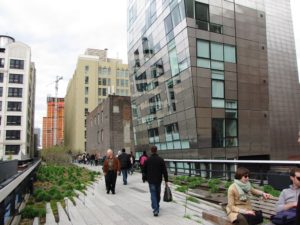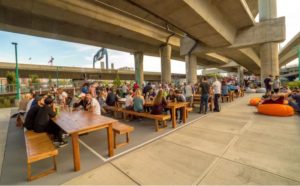As cities worldwide increasingly adopt the 3Re Strategy (repurpose, renew, reconnect) to revitalize, they are being drawn to what most people would consider the nastiest, most dangerous spots in the community: highway underpasses.
These are the places created by highway engineers who either didn’t care about their effect on the neighborhood, or who were told not to worry about it by the city leaders who hired them.

High Line Park, New York City (2013).
Photo credit: Storm Cunningham.
When Manhattan’s High Line opened on the west side in 2009, locals and visitors alike flocked to the revitalized railroad trestle to marvel at its transformation into a gorgeous and walkable park. Arguably the most famous urban adaptive reuse project in America, the High Line made industrial reuse cool, and prompted a wave of creative development.
Since then, cities across the country have worked to reclaim seemingly inhospitable urban infrastructure, from old cisterns to sewage plants.

OkTacoFest helps activate the 8-acre Boston park called the Underground at Ink Block. Photo courtesy of the Underground at Ink Block
Elevated highways and rail lines were long overdue for a makeover. While freeway cap parks—or removing freeways entirely—have become increasingly popular to reunite cities fragmented by urban highways, capping isn’t always feasible.
Instead, many cities are turning transit underpasses into public parks— replacing trash, overgrown weeds, and dark passageways with art installations, funky lights, and pedestrian thoroughfares.
Curbed has rounded up 11 creative examples of transit underpasses that have been transformed.
In Seattle, Washington, a decades-old project turned a downtrodden underpass into a skateboarding destination.
In Toronto, Ontario, a just-completed project created an ice rink under the highway. Other cities included include Boston, Chicago, San Diego, Miami, Portland, Washington, DC, New Orleans, and Houston. They also found a few projects that are still under construction.
All are examples of a new era in underpass design—one that emphasizes high-impact solutions to reconnect neighborhoods and revitalize communities.
Featured image of an underpass park in Houston, Texas is courtesy of Tom Fox / SWA Group.

